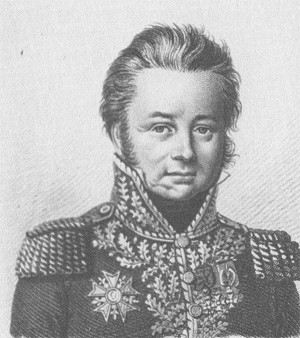General Charles Antoine Louis Alexis Morand

Born: June 4, 1771
Place of Birth: Pontarlier, Doubs, France
Died: September 2, 1835
Place of Death: Paris, France
Arc de Triomphe: MORAND on the east pillar
Pronunciation:
The son of a lawyer, Charles Antoine Louis Alexis Morand initially followed in his father's footsteps and studied to become a lawyer, fulfilling that goal in 1791. By the next year though, he had volunteered with the 7th Battalion of Volunteers of Doubs and was made a capitaine. Within a month of joining the army, he was elected with the rank of lieutenant colonel of his battalion. In 1793 Morand was serving with the Army of the North when he got his first taste of action, distinguishing himself at Hondschoote on the 8th of September. The next month he took part in the Battle of Wattignies . For the next few years Morand served with the Army of the Sambre and Meuse, distinguishing himself at the Battle of the Ourthe and Battle of Aldenhoven in 1794. In 1795 he fought at Kreuznach and then in 1796 he fought at Koenigstien and Teining. In early 1797 Morand transferred to the Army of Italy with Bernadotte's division.
In 1798 Morand joined the Army of the Orient, sailing to Egypt and taking part in the campaigns there as part of Desaix's division. He fought at the Battle of the Pyramids in July and was promoted on the battlefield to chef de brigade by General Bonaparte. During his time in Egypt, he fought at the Battle of Sédiman, Girgeh, El Ganaim, and Samanhoud. In September of 1799 he was made governor of the province of Girgeh and then a year later he was promoted to général de brigade. In May of 1801 he joined Verdier's division and then in June he signed the surrender of Cairo with General Belliard.
After returning to France, General Morand commanded the department of Morbihan until mid 1803 when he joined the camp of Saint-Omer. In 1805 when the Grande Armée marched east he took command of the 1st Brigade of St. Hilaire's division of IV Corps, and he led them into action at the Battle of Austerlitz, where he was wounded by a shot. In recognition of his contributions, he was promoted to général de division before the end of the month. February of 1806 saw Morand given command of the 1st Division of Marshal Davout's III Corps, a position he would hold for the next seven years. During the campaign against Prussia in 1806, he led his men into battle at Auerstädt, where he was wounded by grapeshot in the arm. Continuing to campaign, he fought at Custrin, Bug, Czarnowo, and Golymin before being wounded again at Eylau.
In 1808 Morand was named a Count of the Empire. For the Danube campaign of 1809, Morand continued to command his division, fighting at Arnhofen, Abensberg, Landshut, Eckmühl, Ratisbon, and then being wounded at Wagram . In 1810 Morand had a falling out with Marshal Davout, in part due to his belief that Davout had blocked his advancement. It culminated in a request to be transferred to a different command and a threat to retire, but this request was not granted and he did not retire.1 Despite the personality clashes, both men continued to act as professionals and still performed admirably.
For the Russian campaign of 1812, Morand continued to command his division, though Davout's Corps was now the I Corps. He served at Smolensk and then was wounded at the Battle of Borodino when his jaw was broken in multiple places by grapeshot. After surviving the retreat, in March of 1813 Morand finally got a new command, taking charge of the 12th Division under General Bertrand. In the meantime he was rewarded as a Commander of the Order of Saint Henry of Saxony and he received the Grand Cross of the Order of the Reunion. That year he fought at Lützen and Bautzen, distinguished himself at Dennewitz, and then fought at Wartenburg, Hanau, and Hochheim. Finally he took over command of IV corps from Bertrand and then starting in December of 1813 he directed the defense of Mainz until after Napoleon's abdication in April of 1814.
After the Bourbon Restoration, General Morand was named a Knight of Saint Louis but he retired to Fontainebleau. With the return of Napoleon in 1815 for the Hundred Days, Morand initially served as an aide-de-camp to Napoleon but then he took the position of colonel of the Chasseurs à Pied of the Guard. He served at the Battle of Waterloo, retaking Plancenoit during the battle. After the second Bourbon Restoration, he was put on non-activity before being exiled to Poland and then condemned to death in absentia. In June of 1819 he returned to France and was acquitted of the charges brought against him. After the trial Morand was reintegrated into the army and he retired in 1825.
Notes
- John G. Gallaher, The Iron Marshal: A Biography of Louis N. Davout, (London: Greenhill Books, 2000), 214-215.
Bibliography
- Divry, Arnauld. Les Noms Gravés sur l'Arc de Triomphe. Paris: L'Harmattan, 2017.
- Haythornthwaite, Philip J. Who Was Who in the Napoleonic Wars. London: Arms & Armour, 1998.
- Six, Georges. Dictionnaire Biographique des Généraux & Amiraux Français de la Révolution et de l'Empire (1792-1814). 2 vols. Paris: Gaston Saffroy, 2003.
Related Pages:
Updated March 2022
© Nathan D. Jensen